We receive many questions about Yellowstone National Parks, and the answers may surprise many people. We also think this may be fun trivia for that road trip! Enjoy.
Yellowstone was established March 1, 1872.
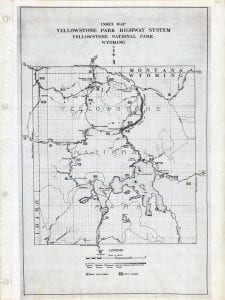
Road Map of Yellowstone
Over the years the boundaries of the national park have been changed. The following dates of boundary changes were found:
May 26, 1926
March 1, 1929
April 19, 1930
October 20, 1932
The park was designated a Biosphere Reserve in 1976 and was designated a World Heritage Site on September 6, 1978,
It is the world’s first national park.
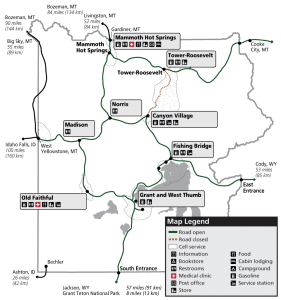
Road Map of Yellowstone
The park covers 3,472 square miles. It contained 2,222,765.13 square acres that are federal; 1.58 acres are non-federal. It is larger than the states of Delaware and Rhode Island combined spanning 63 miles north to south and 54 miles east to west.
The states of Wyoming, Montana and Idaho all claim a portion of the park with 96% being in Wyoming, 3% in Montana and 1% in Idaho.
What is known as the Greater Yellowstone Area is still inhabited by every wild species that were present when Columbus reached the New World 505 years ago. The Greater Yellowstone Area encompasses 12 million acres and includes Grand Teton National Park, John D. Rockefeller, Jr, Memorial Parkway, seven National Forests, three National Wildlife Refuges and a variety of other properties.
Approximately 5% of the park is covered by water while 15% is grassland and 80% is covered by forests.
In terms of precipitation records show that it ranges from 10 inches at its north boundary and 80 inches in the southwest corner.
Temperatures average at Mammoth in January 9 degrees F; July may see 80 degrees F with a record high of 99 degrees F recorded in 2002. The west entrance at Riverside Station posted a low of -66 degrees F in 1933.
It is an active volcano.
There are an estimated 1000 to 3000 earthquakes in the park annually, The park boasts more than 10,000 hydrothermal features with over 300 active geysers.
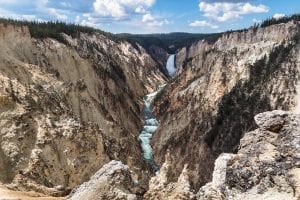
Grand Canyon of the Yellowstone River
It is one of the world’s largest calderas measuring 45 x 30 miles. You can find approximately 290 waterfalls that are 15 feet or higher and they flow year around. The tallest waterfall in the front country is the Lower Falls of the Yellowstone River measuring 308 feet.
Want a little time on the water? Lake Yellowstone is the place for you. The lake has 131.7 square miles of surface area. It boasts 141 miles of shoreline and measures 20 miles north to south and 14 miles east to west. The average depth is 140 feet with a maximum depth of 410 feet.
As far as wildlife is concerned there are 67 species of mammals which include 7 species of native ungulates and 2 species of bears. You can find 322 species of birds 148 of which are nesting species. If fish is your thing, you will find 16 species of fish including 5 which are non-native. Amphibians and reptiles are not to be left out of the count as there are 6 species of reptiles and 4 species of amphibians. There is one threatened species in the park and that is the Canada lynx. The resident gray wolf (which was delisted and relisted in 2008) is the one endangered species.
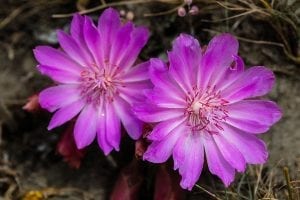
Bitterroot Flowers
You want flowers? In the park you will find 7 species of conifers; approximately 80% of the forest in the park is made up of lodgepole pine. There are approximately 1,150 species of native vascular plants and more than 210 species of (non-native) or exotic plants and 186 species of lichens.
The park has approximately 1,600 archeological sites with more than 24 sites, landmarks and districts are on the National Register of Historic Places. There is one National Historic Trail. More than 900 historic buildings call the park home. You will also find thousands of books, many of which are rare, and there are 90,000 historic photographs.
As far as the park facilities are concerned there are 9 visitor centers, museums and contact stations; 9 hotels/lodges with over 2,000 hotel rooms or cabins. The National Park Services operates 7 campgrounds with over 450 sites. The concessionaires operate 5 campgrounds with over 1,700 sites. If you want to have a picnic in the park you will find 52 picnic areas for your use. There is one marina. If hiking is your thing, there are 13 self-guiding trails.
The park has 5 entrances – 466 miles of roads with 310 miles of those roads being paved.
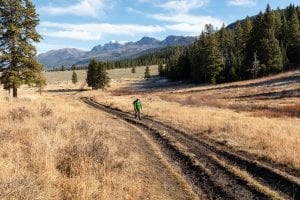
Slough Creek Trail
There are more than 15 miles of boardwalks and approximately 1,000 miles of backcountry trails with 92 trailheads and 301 backcountry campsites.
As you can easily see, there is something for everyone to be found in the park. Whether your interests are geology, historic buildings, hiking, boating, camping or just relaxing amid the wonder of Nature, you will find what you are looking for at our first national park. We encourage you to visit and see it for yourself. There is no other place like it on earth.
All photos courtesy of Yellowstone National Park.
AUTHOR: SUSIE KNAPP